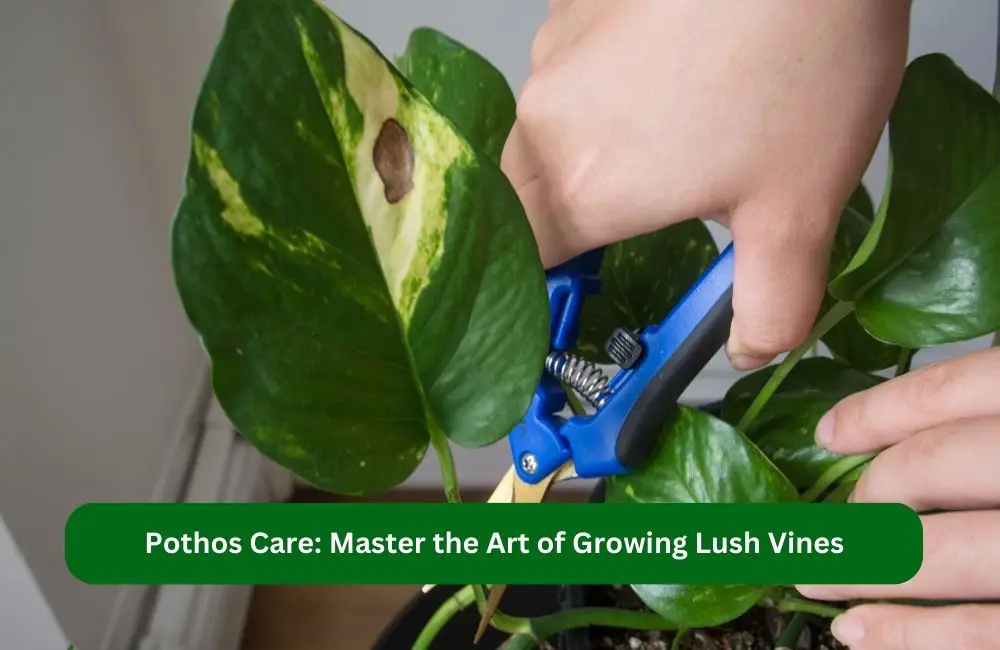This article covers the following areas –
- Guide to Choosing Your Pothos
- Basic Pothos Care 101
- Advanced Level of Care
- Troubleshooting Common Pothos Issues
- Propagating Pothos – Multiply the Beauty
- Final Note
- FAQ: Pothos Care

When I first brought home my first Pothos plant, its glossy heart-shaped leaves and trailing vines had me spellbound. Like many, I was drawn to its beauty, but little did I know that this houseplant would teach me so much about patience, resilience, and growth. Let me take you on my journey of mastering the art of growing lush Pothos vines.
Pothos, a popular houseplant, requires indirect sunlight and well-draining soil. Water when the top 1-2 inches of soil are dry, maintaining a temperature between 65-80°F (18-27°C). Fertilize every 6-8 weeks during growing seasons. Prune for denseness and propagate using vine cuttings.
For a deeper dive into ensuring your Pothos thrives, from choosing the right variety to addressing common issues, continue reading. This comprehensive guide provides all the insights and tips to make your Pothos journey smooth and rewarding.
Guide to Choosing Your Pothos
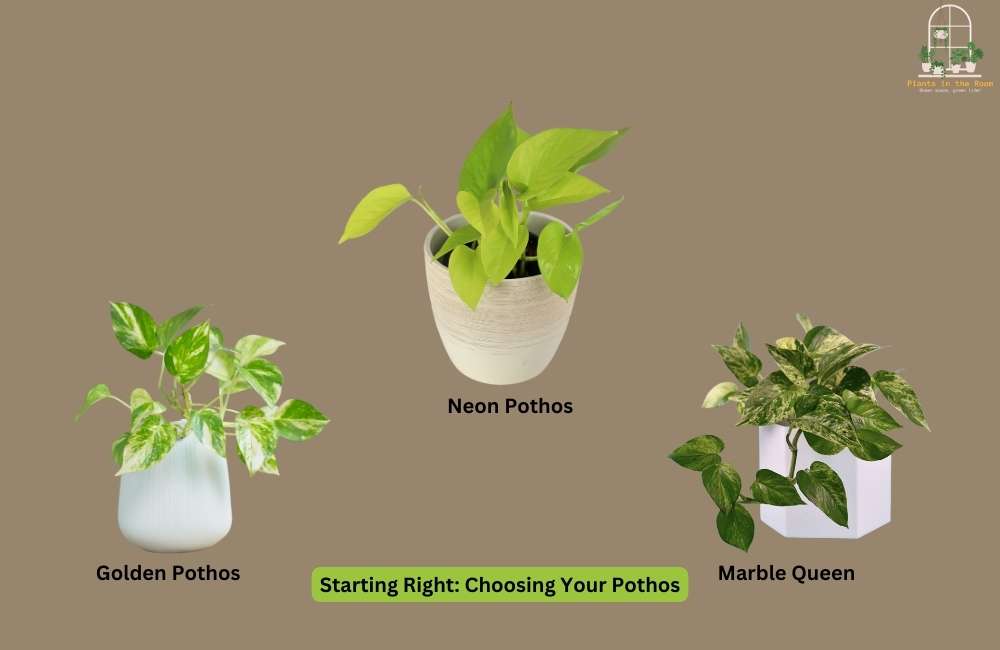
Setting foot into the world of houseplants can be both thrilling and a tad overwhelming, especially when faced with the multitude of options available. The Pothos, known for its adaptability and beauty, is a favored choice for many, including myself. But with its varieties and subtle care differences, how do you ensure you pick the right one?
Like a dog owner would research before adopting a puppy, plant enthusiasts (or soon-to-be ones) should know their options and inspect their new green family members. Let’s delve deeper into the vibrant world of Pothos and unravel the mystery behind choosing the perfect one for you.
Know the Varieties
Just as every individual has a distinct personality, each Pothos variety carries its own unique charm and character. With a lineage that spans several visually captivating members, understanding the diverse world of Pothos can be an enthralling journey. Let’s embark on this botanical tour and meet some of the standout members of this verdant family.
- Golden Pothos: The quintessential, with yellow and green variegated leaves.
- Marble Queen: A delightful blend of creamy white and green, presenting a marbled facade.
- Neon Pothos: A show-stealer with bright, almost neon-green leaves that add a pop to any space.
… And the list doesn’t end here! The beauty of Pothos is in its diversity. The challenge? Finding the one that feels like you.
The Importance of First Impressions
The process of choosing a Pothos, or any plant for that matter, is much like building a new relationship. It starts with a first impression. The initial scanning, observing, and feeling moments can lay the foundation for a nurturing bond. What should you look for when you pick up that potential plant companion? What are the signs that scream, “Take me home!”? Let’s uncover these selection secrets.
Leaf Check
Pothos leaves should be vibrant, irrespective of the variety. Look out for:
- Healthy green shades without any brown or yellow spots.
- No wilting or drooping – that’s a red flag!
The Root of the Matter
A robust Pothos has strong roots. If possible:
- Peek through the drainage holes to inspect the roots.
- They should appear dense but not overly crowded, white or light tan, not brown or mushy.
Understanding Your Space
Our living spaces are extensions of our personalities, intricately woven tapestries of our tastes, experiences, and memories. When introducing a new plant like Pothos into this space, it’s imperative to consider how it fits into this mosaic. Does it bask in the glow of that sunny window? Does its hue complement your room’s palette? Dive in to grasp how to blend the world of Pothos with your personal sanctuary harmoniously.
Light Conditions
While all Pothos varieties love indirect sunlight, some, like the Marble Queen, prefer brighter indirect light to maintain their variegation. Recognize the light conditions in your home to match your Pothos’ needs.
Room Aesthetics
A Neon Pothos can be a bold statement in a minimalist room, while the Golden Pothos might complement a more traditional setting. Visualize your space and imagine which variety would elevate its aesthetics.
By understanding your Pothos options and inspecting your potential plant buddy, you’re on the path to a fulfilling plant-parent journey. So, go on and let the vibrant world of Pothos enamor you!
Basic Pothos Care 101
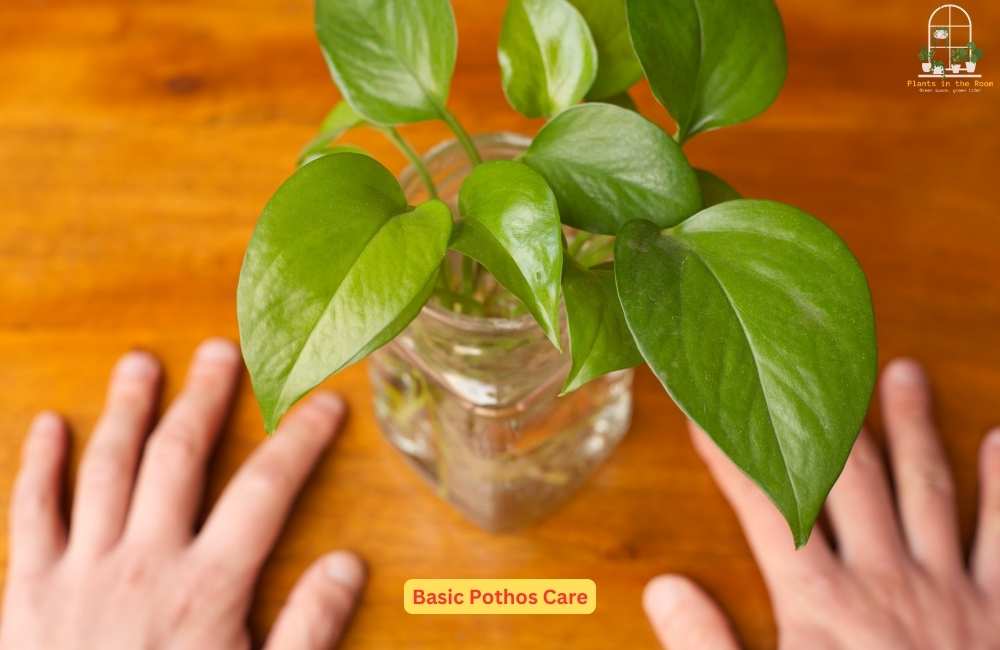
Congrats! You’ve chosen your Pothos, welcomed it home, and now the true journey begins. Just like adopting a pet, plants require love, care, and a bit of knowledge to ensure they thrive. While Pothos is relatively forgiving and adaptable, having some fundamental knowledge can turn your green friend from merely surviving to absolutely thriving.
Whether you’re a seasoned green thumb or an eager newbie, let’s walk through the essentials of Pothos care. Trust me, it’s simpler than it sounds, and the rewards? Absolutely lush!
Light and Positioning
Ah, sunlight! The elixir of life for our green buddies. Here’s what I’ve learned:
- Ideal Spot: Pothos crave indirect sunlight. So, that cozy spot near a north-facing window? Absolutely splendid!
- Sunburn Alert: Direct sunlight can be too harsh and might cause those beautiful leaves to scorch. If you see brown spots on the leaves, it’s a sign they’re getting more sun than they’d like.
Pro Tip: If your living space doesn’t have a north-facing window, placing sheer curtains on windows facing other directions can help diffuse the sunlight, giving your Pothos the desired light.
Watering – The Balancing Act
Watering might seem straightforward, but it’s more of an art with Pothos.
- Touch Test: Before watering, touch the soil. If the top 1-2 inches feel dry, it’s time to quench its thirst.
- Avoid Soggy Soil: Overwatering can lead to root rot. The roots essentially drown, leading to a sad, droopy Pothos. If the pot feels unusually heavy or if you notice a moldy smell, you might be watering too much.
Pro Tip: Using a pot with drainage holes can prevent excess water buildup, making maintaining the right moisture balance easier.
The Right Temperature
Think of your Pothos as someone who enjoys sweater weather. It likes temperatures that are comfortable for most humans.
- Daytime Coziness: Aim for a temperature range between 65-80°F (18-27°C) during the day.
- Nighttime Chill: A slightly cooler environment at night helps mimic its natural habitat.
Pro Tip: Avoid placing your Pothos near air vents, radiators, or drafty windows. Rapid temperature changes can stress the plant.
Humidity – The Unsung Hero
Pothos, originating from tropical regions, enjoy a bit of humidity.
- Natural Humidity: If you live in a naturally humid area, your Pothos will thank you!
- DIY Humidity: In drier climates or during winter, consider placing a humidifier nearby, or you can occasionally mist the leaves.
Pro Tip: Placing the pot on a tray with water and pebbles can help increase humidity around your Pothos. The water evaporates, providing the much-needed moisture without wetting the plant.
Taking care of your Pothos isn’t about having a green thumb but understanding its simple needs. You’re on your way to becoming a Pothos pro by mastering these basics! So, gear up and watch your Pothos flourish in its green glory.
Advanced Level of Care
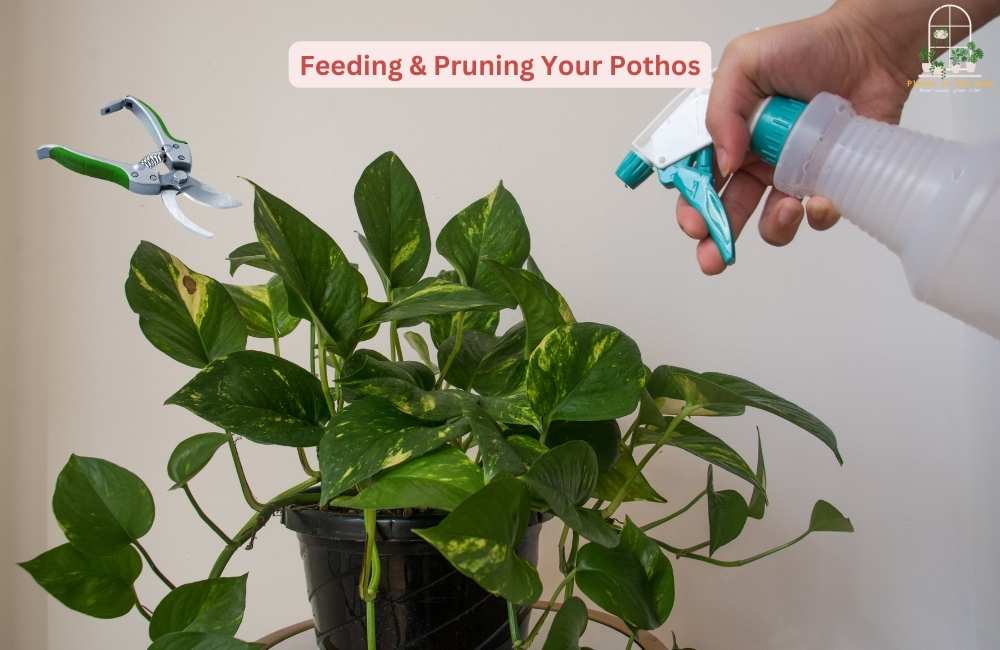
So, you’ve got the basics down. Your Pothos is happily settled in its perfect spot, basking in indirect sunlight, enjoying its watering schedule, and reveling in that cozy temperature range. Now, are you ready to take this relationship to the next level?
Going the extra mile with your Pothos doesn’t mean running a marathon. Instead, it’s about small tweaks and efforts that make a massive difference in ensuring your vine thrives and showcases its most vibrant self. Let’s explore how to become the ultimate Pothos caretaker!
Feeding Your Pothos
Like how we all enjoy a little treat now and then, your Pothos also relishes a nutrient boost.
- Frequency: Feeding it once every 6-8 weeks is ideal during its growth spurt in spring and summer.
- The Right Food: I swear by a balanced liquid houseplant fertilizer. It’s like a wholesome meal for your plant.
- Directions: Always read the label. And as my grandma used to say about spices in food – less is more. Overfeeding can burn the roots.
Pro Tip: If you notice the leaves turning brown or yellow soon after fertilizing, it might indicate fertilizer burn. Next time, dilute the fertilizer a bit more than recommended or extend the time between feedings.
Pruning – Making the Cut
Pruning might sound sophisticated, but it’s pretty much like giving your Pothos a refreshing haircut.
- Why Prune: Beyond aesthetics, pruning encourages denser growth. So, if you want your Pothos to look more like a lush jungle, grab those scissors.
- Technique: Always cut just above a leaf node (that tiny bump where leaves sprout). This promotes new growth right from that point.
- Tools: Clean scissors or pruning shears will do the trick. Ensure they’re sharp to make a clean cut and prevent any damage.
Pro Tip: Don’t throw away the pruned vines! They’re perfect for propagation, meaning you can grow a new Pothos from them.
Listen and Observe
One thing I’ve learned over time is the importance of paying attention.
- Leaf Language: If the leaves are yellowing, maybe you’re overwatering. If they’re brown, they might be getting too much sun. Listening to these signs can guide your care routine.
- Growth Patterns: Slow growth? Your Pothos might be hungry and need some fertilizer. Super long vines without many leaves? Time for pruning.
Pro Tip: Keep a small plant journal. Jotting down when you water, feed, or prune can help you track your Pothos’ needs and reactions. Over time, you’ll see patterns and understand its likes and dislikes.
Embracing these extra steps elevates you from a casual plant parent to a Pothos aficionado. Enjoy the journey, cherish the growth (both yours and the plant’s), and take pride in the lush green haven you cultivate!
Troubleshooting Common Pothos Issues
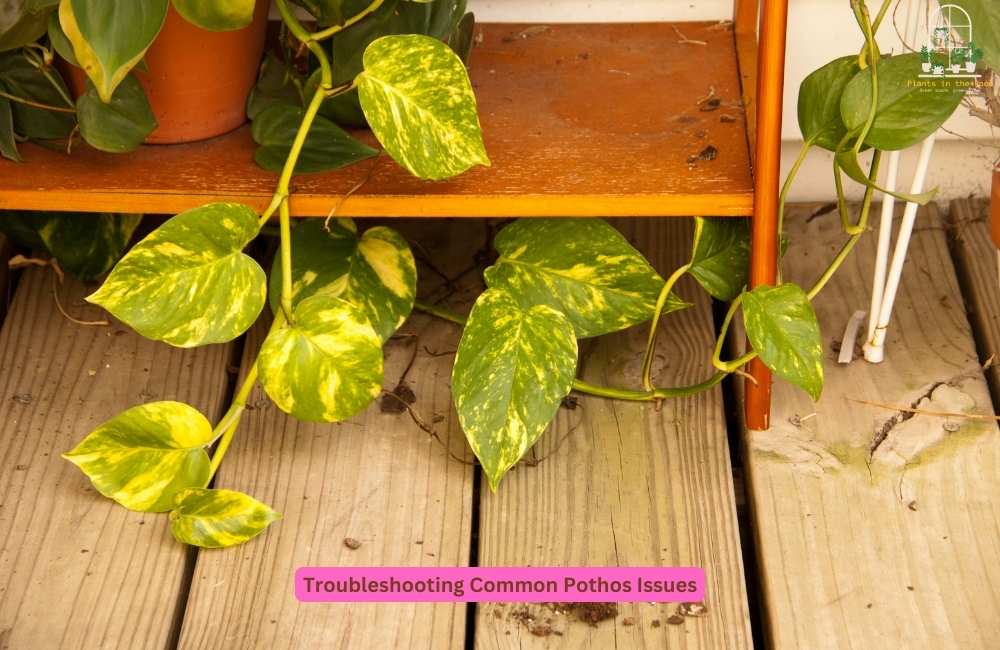
No relationship is without its bumps, and the bond between a plant parent and their Pothos is no exception. While Pothos are generally easy-going, they, like all plants, have their own language of communicating distress. The key is to decode these signs early and take corrective action. Over the years, I’ve played plant detective numerous times, and trust me, there’s always a solution. Let’s delve into some of the common challenges and their remedies.
Yellow Leaves
One of the most common ‘cries for help’ from a Pothos is the dreaded yellow leaf.
- The Culprit: Overenthusiastic watering. While our intention might be to shower it with love, Pothos prefers its soil like a wrung-out sponge – moist but not wet.
- The Fix: First, check the soil. If it’s soggy, give the plant a break from watering until the top 1-2 inches of soil feel dry. If overwatering is recurring, consider repotting with a well-draining soil mix.
Pro Tip: Ensure your pot has drainage holes. This allows any excess water to escape, preventing the roots from drowning.
Leggy Vines
Long, sparse vines might give your Pothos an unkempt look.
- The Culprit: Insufficient light often leads to leggy growth. The plant stretches out, seeking more sunlight, resulting in longer intervals between leaves.
- The Fix: Move your Pothos to a location with brighter indirect light. Remember, direct sunlight can be harsh while they need light, so avoid those rays!
Pro Tip: Rotate your Pothos every few weeks to ensure even growth. Each side gets its fair share of light, promoting a fuller appearance.
Brown Spots on Leaves
Brown spots can be alarming, but understanding their cause can help address the issue promptly.
- The Culprit: Overwatering can cause root rot, leading to brown spots. Alternatively, if the air is too dry, it can cause the leaf margins to turn crispy and brown.
- The Fix: Check the soil. If it’s consistently wet, you know the drill – water less! If the soil moisture seems okay, it’s time to increase the humidity. You can do this by misting the leaves or placing a humidifier nearby.
Pro Tip: Grouping plants together can also increase humidity. Plants release water vapor, and having them together can create a mini tropical environment.
Remember, every plant hiccup is an opportunity to learn and understand your Pothos better. It’s all part of the plant-parenting journey. With some observation, patience, and love, your Pothos will return to its vibrant self in no time!
Propagating Pothos – Multiply the Beauty
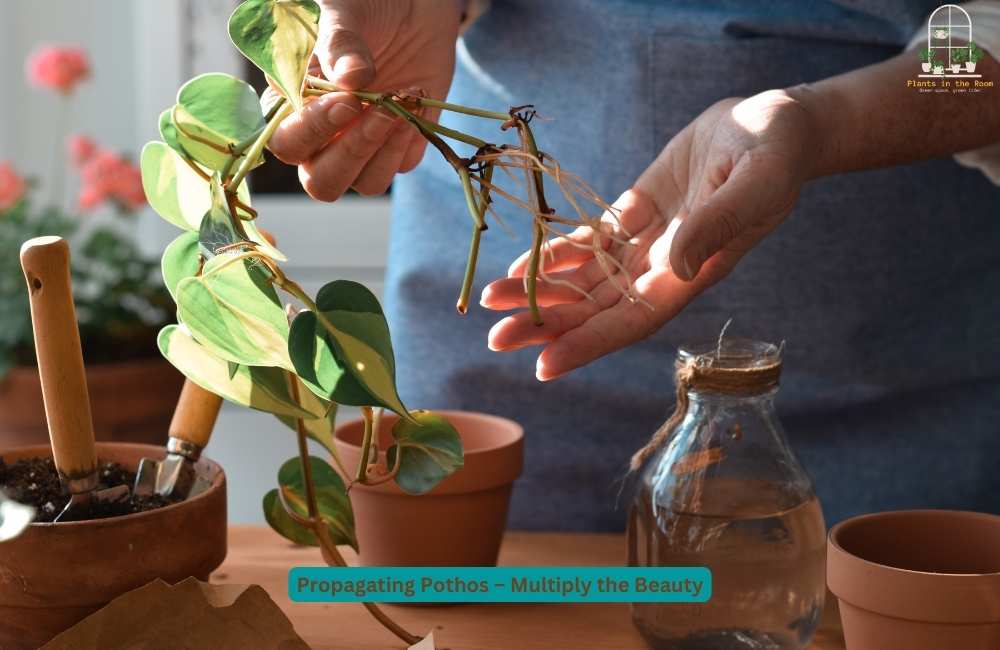
For many plant enthusiasts like myself, the thrill of watching a new plant grow from a mere cutting is unparalleled. It’s like performing a magic trick: you take a snippet of your beloved Pothos, give it a bit of TLC, and before you know it, you’re gifting friends and family with plants you’ve birthed. Propagation is sustainable, cost-effective, and incredibly gratifying. Ready to replicate that Pothos beauty? Let’s get cloning!
Cutting
Starting right is half the battle won. Here’s what you need to know:
- Choosing the Vine: Pick a healthy, vigorous vine from your Pothos. It should be free from any signs of disease or stress.
- Length: A segment of about 4-6 inches is ideal. Remember, longer isn’t necessarily better here.
- Making the Cut: Snip just below a node using a clean, sharp pair of scissors or pruning shears. This node will be your root’s birthplace.
Pro Tip: When selecting a segment, choose one with at least 3-5 leaves. This gives the cutting ample energy to focus on rooting.
Rooting in Water
This is where the magic unfolds:
- Container Choice: Almost any clear container will do – from a mason jar to a simple glass. Clear containers let you monitor root growth.
- Positioning: Place the cut end into the water, ensuring that the node (but not the leaves) is submerged.
- Waiting Game: Place the container in a spot with indirect light and watch patiently. You should see tiny roots sprout from the node in a few weeks.
Pro Tip: Change the water every few days to keep it fresh and free of microbial buildup.
Transplanting
The final step to achieving your new Pothos:
- Timing: Once the roots have grown a couple of inches long, they can be planted in soil.
- The Planting Process: Fill a pot with well-draining potting soil. Make a small hole, gently place the rooted cutting inside, and cover with soil. Water lightly.
- Adapting: Initially, the new plant may experience a bit of transplant shock as it adjusts from water to soil. But don’t fret; keep it in indirect light and maintain consistent care.
Pro Tip: Before planting in soil, you can dip the roots in the rooting hormone. While unnecessary, it can boost your cutting, helping it establish faster in its new home.
There you have it – from one comes many! Propagation is a testament to the beauty of nature and its endless cycle of growth and renewal. So next time you’re pruning or notice a healthy vine, consider propagation. It’s one gift that truly keeps on giving!
Final Note
Pothos, with its lush vines and heart-shaped leaves, is more than just an ornamental delight; it’s a testament to the resilience and adaptability of nature. As you embark on your plant-parenting journey, remember that every Pothos tells a story, from the vines that have grown long and meandering to each leaf that captures a chapter of its life.
While it might initially seem daunting, caring for this resilient plant can be a fulfilling experience, teaching us patience, observation, and the sheer joy of nurturing. With the right knowledge and consistent care, your Pothos will survive and thrive, adding a touch of nature’s beauty to your space.
Whether you’re a seasoned plant enthusiast or a budding green thumb, the Pothos offers endless lessons in growth, both for the plant and its caretaker.
FAQ: Pothos Care
1. What is Pothos?
Pothos, scientifically known as Epipremnum aureum, is a versatile and hardy houseplant celebrated for its cascading vines and heart-shaped leaves. It’s also commonly known as the “Devil’s Ivy” due to its resilience and ability to thrive in a variety of conditions.
2. How much light do Pothos plants prefer?
Pothos plants are adaptable and can thrive in a range of light conditions, from low to bright indirect light. However, they should be shielded from prolonged direct sunlight, which can scorch their leaves.
3. How often should I water my Pothos?
Water your Pothos when the top inch of the soil feels dry to the touch. These plants are drought-tolerant, so it’s better to err on the side of underwatering than overwatering.
4. Why are the leaves on my Pothos turning yellow?
Yellow leaves can be a sign of over-watering or poor drainage. Ensure the plant’s pot has adequate drainage holes, and adjust your watering schedule if the soil feels overly moist.
5. Is it possible to prune Pothos plants?
Yes, Pothos can be pruned to maintain its shape and encourage bushier growth. Trimming the vines also helps stimulate new growth and can invigorate an older plant.
6. Are Pothos plants toxic to pets?
Yes, Pothos leaves contain calcium oxalate crystals, which can be harmful if ingested. It’s best to place them out of reach of pets, especially cats and dogs.
7. How can I propagate my Pothos plant?
Pothos is easily propagated through stem cuttings. Snip a segment with at least 4-5 leaves, place it in water, and wait for roots to develop. Once rooted, you can transfer it to soil.
8. What type of soil is best for Pothos?
A well-draining potting mix is ideal for Pothos. You can use a general-purpose houseplant mix or enhance drainage by adding perlite or sand.
9. My Pothos seems to attract pests. What should I do?
Pothos can occasionally become a target for pests like spider mites or aphids. If you notice any infestation, treat the plant promptly with insecticidal soap or neem oil.
10. My Pothos isn’t growing as quickly as I’d like. How can I boost its growth?
Ensure your Pothos has adequate light and consider feeding it with a balanced liquid fertilizer during its growing season. Proper care, including regular watering and occasional pruning, can also promote faster growth.

